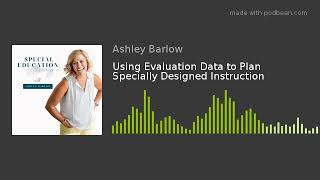Using Evaluation Data to Plan Specially Designed Instruction
Using Evaluation Data to Plan Specially Designed Instruction

https://www.podbean.com/eau/pb-6eeq7-f460a1
You’ve probably heard me say, “Data drives instruction.” Here’s a new one for you. “Evaluation data plans specially designed instruction.” It doesn’t roll off the tongue as easily, and it means the same thing. It’s just far more specific and really, really important. There are way too many IEPs out there that aren’t specially designed to a child’s unique needs – that don’t take a child’s profile into account – that don’t consider a child’s specific strengths and weaknesses. That’s a problem. The heart of the IEP is the specially designed instruction. It’s supposed to be uniquely tailored to meet the needs of the child, but far too often, a school district will say, “We use [this program] for dyslexia” or “Our students in the self-contained room use [this program] for math” or “Our visually impaired students get O&M twice a week.” That. Is. Not. SDI. We’re supposed to take information from evaluations and progress monitoring and then use it to specially design instruction for students. We’re supposed to look at a student’s strengths and teach to them, capitalize on them. We’re supposed to look at a student’s weaknesses and address them.
We rely on data in our every day lives all the time. We look at the gauges in our cars, health and exercise information on our phones, and the temperature on our thermostats. We use that data to make plans. If we’re hot, we look at the thermostat and turn down the heat, remembering that 74 degrees is too hot. We work harder when our heart rates aren’t elevated. We walk a little further when we haven’t hit the 4-mile mark. If we want to improve on something, we use the data and make a plan. If I want my resting heart rate to be lower, I decide to eat better, to exercise, to meditate, and to get acupuncture.
We have to use that kind of data to plan instruction for students on IEPs. We need to look at what the evaluation tells us to make a plan. Evaluations tell us so much about a child’s profile. An incomprehensive list of things we may evaluate includes visual, verbal, motor, cognitive, sensory, communication, vision, and hearing skills and strength / needs and weaknesses.
We should take what we know about the child’s specific profile and make a plan for learning that capitalizes on the child’s strengths and addresses the child’s needs. If a child is really visual, we should ensure that there are lots of visual supports in his learning. If a child’s auditory processing is impaired, her specially designed instruction should not necessitate a lot of auditory processing. If a child needs sensory regulation to condition herself to learning, those strategies should be added to supplementary aids and services.
Parents and sometimes even teachers or other IEP team members often know very little about specific programs that other school staff want to use. In order to ensure that programming and instruction are specially designed to meet the child’s unique needs, IEP team members should ask questions, such as, “How does this capitalize on my child’s strengths” and “How does this address the [i.e. auditory processing] need?” I’m going to load a Freebie on Friday with a list of questions that may guide these discussions.
Of course, after the SDI is planned and instituted, teams should continue to take data to evaluate how well it’s working. Similarly, we do this in other places. If I start eating oatmeal and meditating, I’ll check my resting heart rate to see if those two changes brought it down. This is why progress monitoring is important. And yes, I’ll say it again, “Data drives instruction!”
And – before I leave you to listen – we’re celebrating 1000 downloads on our little podcast this week! Would you help me celebrate by rating it and commenting? It would mean the world to me!
